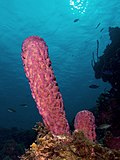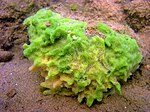[citation needed] Archaeocytes (from Greek archaios "beginning" and kytos "hollow vessel") or amoebocytes are amoeboid cells found in sponges. They are...
2 KB (224 words) - 16:35, 2 August 2024
contract. "Grey cells" act as sponges' equivalent of an immune system. Archaeocytes (or amoebocytes) are amoeba-like cells that are totipotent, in other...
129 KB (13,202 words) - 07:56, 25 August 2024
They form by migration of food-filled archaeocytes, also called amoebocytes, into discrete masses. This archaeocyte core becomes enveloped in several different...
9 KB (960 words) - 22:53, 25 October 2023
non-living material, the mesohyl contains living cells called archaeocytes. Archaeocytes are specialized cells that can modify themselves according to...
21 KB (2,064 words) - 23:58, 2 August 2024
change into other cell types. In sponges, amebocytes, also known as archaeocytes, are cells found in the mesohyl that can transform into any of the animal's...
4 KB (378 words) - 11:14, 23 January 2024
sponges. Spicules are formed by sclerocytes, which are derived from archaeocytes. The sclerocyte begins with an organic filament, and adds silica to it...
71 KB (7,846 words) - 18:49, 18 September 2024
choanocytes. They contain a matrix composed of proteins and spicules. Archaeocytes are special types of cells, in that they can transform into all of the...
36 KB (4,539 words) - 02:53, 25 December 2023
then capture the sperm and transport them to the eggs of the sponge via archaeocytes. Fertilization takes place in the mesenchyme of the sponge. They then...
6 KB (696 words) - 14:01, 22 February 2024







